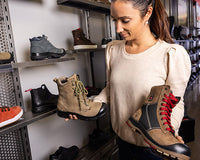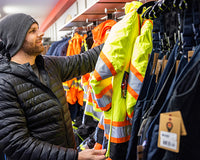What material should you choose for your shoe?
The upper, the part of the shoe that sits above the sole, is an important part of the shoe. Depending on your occupation, you will want an upper that has certain characteristics. Here are some of the things to look for when choosing upper material:
- Waterproofing;
- Ease of treatment or cleaning;
- Stiffness or flexibility;
- Drying time;
- Resistance to heat (or cold);
- Protection against certain products (oil, chemical, manure, etc.).
Types of leather :
Leather is the oldest material for making a shoe. It is still today the material of choice to design the upper. There are 3 types of leather with their own characteristics:
Full grain leather :
This leather having kept its upper surface intact, will therefore have a greater density of fiber. It will then offer more resistance than other leathers. It will be easier to treat and to clean. However, if it has not been waterproofed, it is best to maintain it to increase its durability.
Nubuck:
Nubuck leather has received a special treatment that makes very fine hairs appear on the surface. It will be a little more flexible and offers a different look. It is however less resistant to marks, dirt and sunlight. To keep its original look, it will need to be treated more frequently.
Suede:
Suede will be the most flexible and malleable of the three types. It will however offer less support to the ankle and will be the least water resistant. Its maintenance is comparable to nubuck. Suede comes from a leather that is of lower quality than full grain or nubuck.

Other types:
Even though many shoes are made with leather uppers, there are also other materials that will be able to meet the demands of many professions.
Microfiber:
Microfiber is an imitation of leather. It does not come from an animal which makes it a vegan choice. Like full grain leather, it will offer a better resistance to water and dirt. It will be easy to wash and maintain. Quality microfibers can even outperform the best full grain leather. Microfiber usually offers better resistance to pathogens, dairy products, animal fats, lactic acids (manure) and various chemicals.
Ballistic Nylon:
This material is lightweight, good abrasion resistance, and requires minimal maintenance. It is very easy to wash. This makes it an excellent choice for jobs that get very dirty. However, it could melt under extreme heat or in contact with certain chemicals.
Textile:
Textile is used for shoes. It is a light and breathable material. Aesthetically, it offers a wider variety of styles. Its cost is also lower. However, it is not waterproof and stains easily if it has not been treated, and offers less resistance to cuts and tears. This is why it is used more for indoor jobs (storage, handling, manufacturing...).

What to choose?
What should you choose as a type of rod?
That's a good question and it depends on several factors.
Here are some things to keep in mind:
- If you want a laced shoe that offers more protection from chemicals, choose microfiber. Check with our consultants to see which material is best for you depending on the chemicals in question.
- If you work with concrete, choose a ballistic nylon shoe with a waterproof membrane.
- Microfiber is a good alternative to full grain leather if you want a vegan product.
- If you want a more resistant shoe, choose a model with treated leather (waterproof).
- If you want a light and affordable shoe, choose a textile shoe.
- If your job does not require a material with specific properties and you want an all-purpose shoe that is flexible, easy to clean, and durable, leather is often the appropriate choice.
If you have any questions, our consultants will be happy to answer them and help you choose the right shoe!
Visit one of our stores or write to our customer service department at info@belmont-inc.com.



